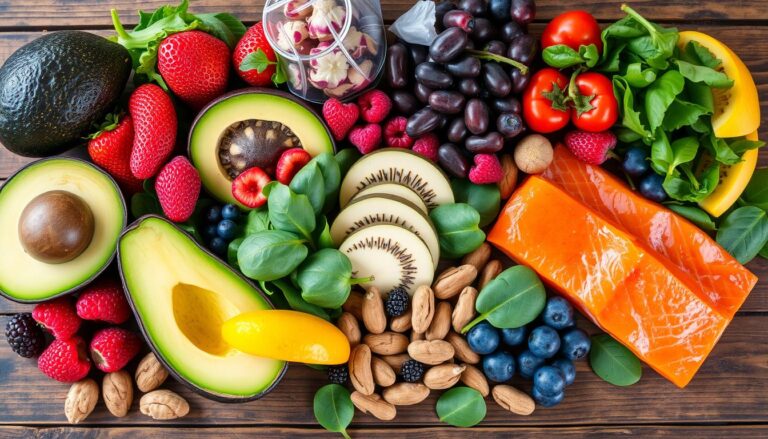Imagine a world where your plate is full of vibrant, nutrient rich foods. These foods not only feed your body but also help the planet. Welcome to the world of plant-based diets, where health and eco-friendliness meet.
Plant based diets can help you manage your weight, prevent chronic diseases, or just live more sustainably. They offer a natural way to improve your health from the inside out.
At the core of this movement is the idea that our bodies do best with plant-based foods. These include fresh fruits, veggies, whole grains, and legumes. These foods are packed with fiber vitamins minerals and antioxidants.
They give your body the nutrients it needs to work well. By eating these foods and avoiding meat dairy, and processed foods, you can naturally nourish your body and reach optimal health.
Key Takeaways
- Plant-based diets are rich in essential nutrients and can promote weight management, heart health, and chronic disease prevention.
- A whole-food, plant-based diet emphasizes the consumption of unprocessed, plant-based foods while avoiding meat, dairy, and eggs.
- Plant-based eating is a more sustainable and environmentally-friendly way of nourishing your body.
- Adopting a plant-based lifestyle can be a cost-effective approach to healthy living.
- Dispelling myths about plant-based nutrition can empower you to make informed choices for your well-being.
What is a Whole-Food, Plant-Based Diet?
A whole-food, plant-based WFPB diet focuses on eating whole minimally processed plant foods. It also limits or avoids animal products. This diet is different from a vegan diet, which doesn’t allow any animal derived ingredients. The WFPB diet is more flexible, letting you have small amounts of animal-based foods.
The Principles of a Whole Food, Plant Based Diet
The main ideas of a WFPB diet are to eat whole, unrefined plant foods. This includes fruits, vegetables, whole grains legumes nuts, and seeds. It also means avoiding or cutting down on processed refined foods and animal products like meat, dairy, and eggs.
This way of eating focuses on eating foods that are rich in nutrients and not heavily processed. It helps nourish your body and support your health.
The Difference Between Plant Based and Vegan Diets
WFPB and vegan diets share many similarities, as both focus on plant-based foods. But WFPB is more flexible. It allows for small amounts of animal products like meat dairy or eggs sometimes. The main goal of a WFPB diet is to eat whole, minimally processed plant foods.

Focus on big changes like switching to whole plant-based foods for measurable improvements in health. Forks Over Knives founder
The Benefits of a Plant Based Diet
Choosing a whole-food, plant-based diet brings many health perks. It’s great for weight loss because it’s high in fiber and low in calories. This makes you feel full and eat less. Plus, it’s linked to a lower risk of heart disease, the top cause of death in the U.S..
Plant-based diets also help lower cholesterol levels and blood pressure. These are big factors in heart disease.
Easy Weight Management
A plant-based diet is great for weight loss and keeping a healthy weight. Whole plant foods are filling and low in calories. This helps you eat less and stay at a healthy weight. It’s also linked to a lower BMI and less obesity risk.
Improved Heart Health
Going plant-based is good for your heart. It cuts down on meat, which is high in cholesterol and saturated fat. This lowers the risk of heart disease and stroke. It can even help prevent and reverse type 2 diabetes.
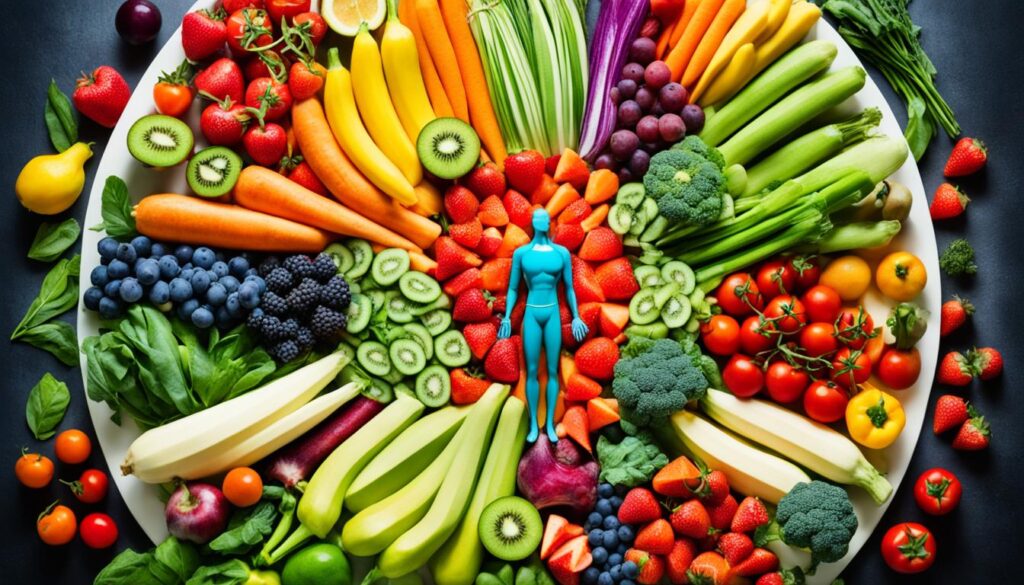
Consuming less meat decreases the risk of heart disease, stroke, obesity, high blood pressure, high cholesterol, type 2 diabetes and many cancers.
| Diet Type | Description |
|---|---|
| Vegan | Excludes meat, fish, dairy, eggs, honey, and any animal-derived products. |
| Vegetarian | Plant-based and may include dairy and eggs. |
| Flexitarian | Occasionally includes meat or fish but primarily consists of plant foods. |
| Plant-based | Emphasizes plant-based foods but may include meat as a secondary component. |
Adding foods like tofu, lentils, chickpeas, beans, nuts, and legumes to your diet gives you lots of protein. Also, vegetables like artichokes broccoli spinach, and sweet potatoes are great for protein too.
Switching to a plant-based lifestyle is a big win. It brings many benefits, like better weight management, improved heart health, and less risk of chronic diseases.
Preventing and Managing Chronic Diseases
Eating a diet based on whole foods and plants can help with weight control and heart health. It also lowers the risk and eases symptoms of chronic diseases. Foods rich in fruits, vegetables, and other plant nutrients may cut the risk of cancers like breast, prostate, and digestive system cancers.
Reducing the Risk of Cancer
Plant-based foods are full of antioxidants and phytochemicals. These can slow down brain aging and protect against Alzheimer’s disease. Eating more plants can also help control blood sugar and lower the chance of getting type 2 diabetes.
Slowing Cognitive Decline
A study with 126,394 UK Biobank participants found that eating a healthy plant-based diet was good for health. It was linked to fewer deaths, cancers, and heart diseases. Those eating the most plant-based foods had a lower risk of dying, getting cancer, and heart disease.
Plant-based diets were also found to reduce the risk of heart attacks and strokes. But eating unhealthy plant-based foods was linked to higher health risks5.
In 2008, 63% of deaths worldwide were from chronic diseases like cancers and heart disease. Places where people eat more plants have fewer chronic diseases than areas with more animal-based diets. Eating lots of plants can lower the risk of chronic diseases.
Some genes make people more likely to get heart disease, but eating lots of fruits and vegetables can help. Plant-based diets can also stop cancer from growing by blocking blood vessels to tumors. The American Institute for Cancer Research says eating plants and staying active can prevent many cancers6.
Some foods like cinnamon and watercress can help prevent cancer and chronic diseases.

Plant based diets and Diabetes
Eating a whole-food, plant-based diet can help manage and prevent type 2 diabetes. Studies show that such diets lower the risk of diabetes more than non plant based diets. They also improve blood sugar weight, and cholesterol in people with diabetes. Foods high in fiber and low in calories help control blood sugar and boost metabolic health7.
In a study, 37% of type 2 diabetes patients went into full remission on a whole-food, plant-based diet. Patients used fewer diabetes medications and saw better blood sugar control.
High fiber foods slow down blood sugar spikes and make insulin work better. Plant-based diets also made people feel fuller and stick to their diets.
Whole grains and legumes in these diets lower blood sugars after meals. Fiber in grains can also make insulin work better. Exercise helps improve blood sugar levels in type 2 diabetes patients. Dr. Caroline Messer found that whole grain high-fiber diets improve insulin sensitivity.
Previous studies showed that eating more plants can help with diabetes. Losing weight, exercising, reducing stress and avoiding alcohol are good for diabetes treatment. Planning meals ahead helps include more whole and plant based foods.
Making protein a key part of plant-based meals can also help with feeling full and getting enough nutrients.
Genetics, age, and diabetes history can affect how well someone can manage diabetes. The study had some limits being a case series without a control group.
A study found diabetes rates in the US went up from 1988 to 2012. Lifestyle changes or taking metformin can lower the risk of type 2 diabetes, as shown in a 2002 study. Eating more plants was linked to a lower risk of type 2 diabetes in the US, a 2016 report said.
Legumes in a low glycemic index diet helped control blood sugar and heart risk in type 2 diabetes patients, a 2012 study found. Meta analyses showed meat eating is linked to higher blood sugar and insulin levels an American Journal of Clinical Nutrition study in 2015 said.
Red meat was found to increase the risk of type 2 diabetes in studies in 2011 and 2013.
Vegan diets had a 2.9% diabetes rate, compared to 7.6% in nonvegetarians. Processed meat was linked to one in five new diabetes cases. Red meat was found to increase diabetes risk by 74% compared to vegetarian diets. Whole grains were linked to a 26% lower diabetes risk9. Drinking sugar-sweetened beverages daily increased diabetes risk by 27%.
A low-fat, plant-based diet reduced liver and muscle fat by 34.4% and 10.4% respectively. A whole food, plant based diet improved insulin resistance in just seven days. Losing weight cuts down HbA1c by 0.1 percentage point for every kilogram lost. High saturated fat intake was linked to lower insulin sensitivity, even without weight changes.
The Environmental Impact of Plant Based Eating
Switching to a plant-based diet is good for your health and the planet.
Studies show that diets low in animal products like vegan and vegetarian are best for the environment. These diets cut down on greenhouse gases water use, and land needed for food compared to meat heavy diets. By choosing plant-based foods over factory farmed meat and dairy, you support greener farming and reduce your carbon footprint.
Reducing Your Carbon Footprint
Going plant-based has big environmental perks.
Vegans produce 25.1% less greenhouse gases and use 25.1% less land than meat lovers. They also use 46.4% less water and risk less eutrophication, and harm biodiversity by 34.3%. There’s a big difference in environmental impact between eating a lot of meat and eating less meat.
In 2015 food production was responsible for 18 Gt of CO2e emissions, making up 34% of global emissions. Eating more plants is a key way to cut your carbon footprint and help the planet.
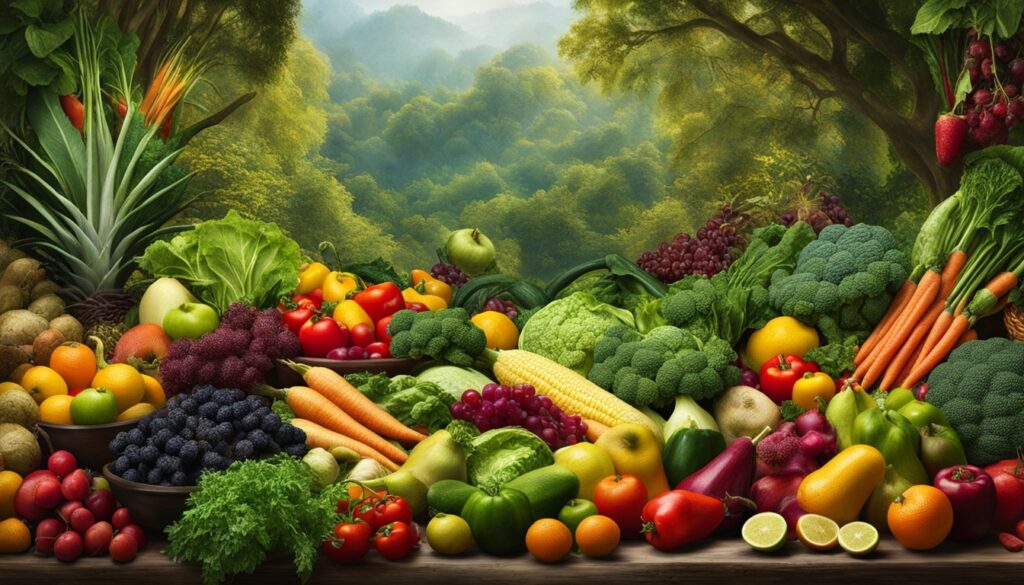
The research highlighted the need for future U.S. dietary guidelines to consider environmental sustainability and recognize that not all plant-based diets offer the same health and environmental benefits.
Not all plant-based diets are the same. Some less healthy ones use more land and fertilizer than others. Red and processed meats are the worst for the environment using a lot of water, land, and fertilizer. Choosing a whole-food, plant-based diet is key to getting the most environmental benefits from eating sustainably.
Foods to Enjoy on a Plant Based Diet
Embracing a whole-food plant-based lifestyle means focusing on a variety of nutrient-dense foods. These include fruits, vegetables, whole grains legumes nuts, and seeds. By eating a colorful mix of these foods, you make sure your body gets all the vitamins minerals, and plant compounds it needs.
A Plant-Based Shopping List
Creating a plant-based grocery list helps you stock up on ingredients for a healthy diet. Here are some key foods to add to your list:
- Berries: Blueberries, raspberries, strawberries
- Citrus fruits: Oranges, grapefruits, lemons, limes
- Leafy greens: Kale, spinach, romaine lettuce
- Cruciferous vegetables: Broccoli, cauliflower, Brussels sprouts
- Starchy vegetables: Sweet potatoes, butternut squash
- Whole grains: Quinoa, brown rice, oats, whole wheat bread
- Legumes: Lentils, black beans, chickpeas
- Nuts and seeds: Almonds, walnuts, chia seeds, flaxseeds
- Healthy fats: Avocados, olive oil, nut butters
Shopping for these whole, minimally processed foods lets you make tasty, nutritious meals. These meals support your health.
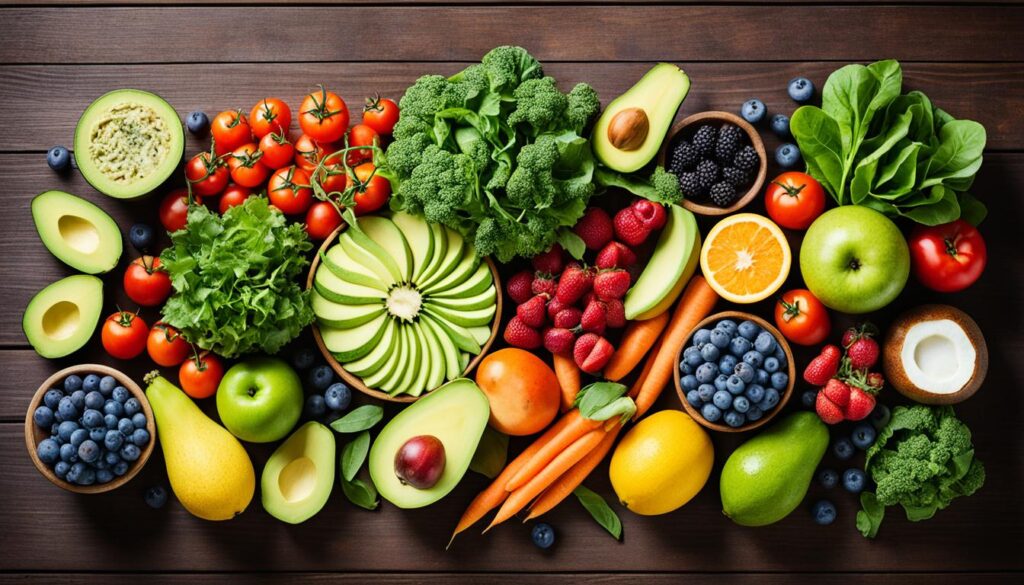
Eating a plant-based diet full of diverse foods helps meet your nutritional needs. It also promotes a healthy lifestyle.
Getting Started with a Plant Based Lifestyle
Starting a whole-food, plant based lifestyle doesn’t have to be hard. Experts suggest making small changes over time instead of changing everything at once.
A good first step is to add more plant-based foods to your meals like eating more legumes, whole grains, and starchy vegetables.Then you can start replacing animal products with plant-based ones.
It’s up to you whether you jump right in or take it slow. The important thing is to make changes that fit your life and taste. Buying meal kits with plant-based options can make it easier to eat this way. Meal delivery services also offer pre-made plant-based meals or ingredients, making it simpler to eat more plant-based foods.
Plant-based diets are often lower in calories, saturated fats, and cholesterol but higher in fiber, vitamins, and minerals.People thinking about a plant-based diet should make sure to get enough vitamin B12 through supplements or fortified foods like cereals and plant milks.
Starting gradually with a plant-based diet can be beneficial.
Plant-based diets are good for everyone, including kids pregnant or breastfeeding women, and athletes. Important nutrients to watch for in a plant-based diet are calcium, vitamin , vitamin B-12, iron, zinc, and iodine.
The path to a plant-based lifestyle is yours to take. Embrace the changes at your own pace. Enjoy the benefits of eating whole, plant-based foods step by step.
Plant Based Diet for Beginners Meal Ideas
Starting a plant-based lifestyle is easy with a bit of creativity. You can make tasty and healthy plant-based meal ideas for beginners. Try making bean chilis, veggie stir-fries, grain bowls or plant-based casseroles. There are so many options.
Simple and Delicious Plant Based Recipes
Discover beginner plant-based recipes that are simple to make and full of flavor. Use canned or dried beans nuts seeds, whole grains fruits, veggies, and soy products like tofu and edamame for easy plant-based cooking16.
Creating plant-based meal plans is easy too. Many recipes are great for batch cooking and meal prep. This helps you stick to your new, healthier eating habits.
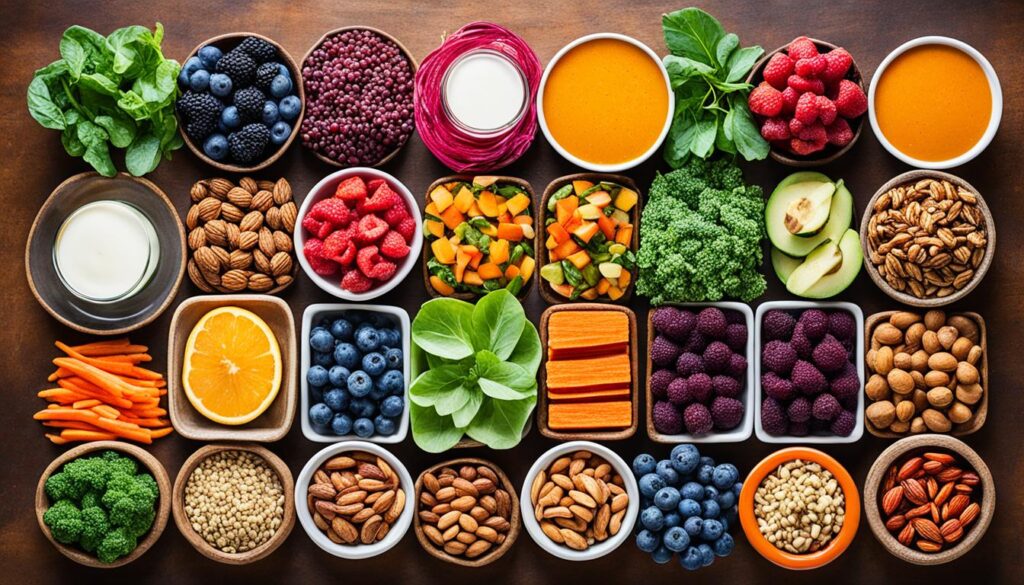
Craving wild rice and mushroom soup or a chickpea sandwich? These plant based meal ideas have you covered. With some experimentation and an open mind, you’ll find many delicious and healthy plant-based options.
The more varieties of plant foods you eat, the more nutrients you’ll get, and the more you’ll enjoy your plant-based diet.
So, jump in and explore the exciting flavors and textures of plant-based cooking. Your body and taste buds will be grateful.
The Cost Effectiveness of Plant Based Eating
Choosing a whole-food, plant-based diet can save you money. Studies show that people who eat plants tend to spend less on food than those who eat meat. In Portugal, eating plants was linked to spending less on food.
Many plant-based foods like beans, lentils, whole grains, and fruits are affordable. This makes it easy to make tasty budget friendly plant-based meals without the high cost of meat and dairy. A study found that eating plants can cut grocery bills by 10-14% compared to eating meat.
| Diet Type | Cost Savings |
|---|---|
| Vegan | Up to 33% reduction |
| Vegetarian | Second most cost-effective |
| Flexitarian low meat/dairy | 14% reduction |
| Pescatarian | Up to 2% increase |
A study showed that eating vegan vegetarian, or flexitarian in rich countries could cut food costs by up to a third. This looked at whole foods and didn’t include processed meat or eating out.
Plant-based eating is good for your wallet and health. If 10% of people in Belgium and the UK ate more plants, it could save over €1 billion and £5 billion over 20 years. Eating soya could also lower the risk of many diseases.
By choosing affordable plant-based foods and budget-friendly plant-based meals, you can eat well and save money. With some creativity and planning, a plant-based diet is easy and affordable.
Plant Based Nutrition Dispelling Myths
Plant-based diets are getting more popular, but many people still think they’re not good for you. One big myth is that you can’t get enough protein from plants. But, it’s actually easy to get enough protein from foods like beans, lentils, tofu, tempeh, and quinoa.
Many think getting enough calcium on a plant-based diet is hard. But leafy greens calcium set tofu, and fortified plant based milks are great sources of calcium.
Vitamin B12 is often linked to animal products, but plant-eaters can get it from supplements or B12-fortified foods. With some planning a plant-based diet can give you all the nutrients you need.
The book ‘Nourish: The Definitive Nutrition Guide for Families’ by Dr. Shah and Brenda Davis provides practical advice and recipes for plant-based diets for families.
Many pediatric and nutrition groups support plant-based diets for pregnant women infants, and kids. They say these diets can help with growth and health.
The U.S. Dietary Guidelines suggest kids eat 2–3 servings of dairy daily. But high dairy intake isn’t linked to better health and can lead to bone fractures. Also 70% of people worldwide can’t digest lactose the sugar in milk.
With some knowledge and planning, plant-based diets can be great for you and your family. By clearing up myths, we can see the health and environmental benefits of this way of eating. The key is to be open-minded and try new tasty ways to feed your body.
| Nutrient | Plant Based Sources |
|---|---|
| Protein | Beans, lentils, tofu, tempeh, quinoa |
| Calcium | Leafy greens, calcium-set tofu, fortified plant-based milks |
| Vitamin B12 | Supplements, B12-fortified foods |
| Vitamin D | Sun exposure, supplements |
Conclusion
Choosing a whole food plant-based diet is great for your health and the planet. It means eating foods that are minimally processed and plant based.
This way, you get to enjoy tasty nutritious meals and lower your risk of chronic diseases. It also helps the environment by reducing greenhouse gas emissions and supporting a sustainable food system.
Starting a plant-based lifestyle might seem hard at first, but there’s lots of help out there. You can jump right in or make changes slowly. The benefits for your health and the planet make it a good choice.
So, why not start a healthier, greener, and tastier way of eating? Your body, the planet, and your taste buds will be grateful. Dive into whole-food, plant-based eating and explore the many benefits of a plant-based lifestyle.



